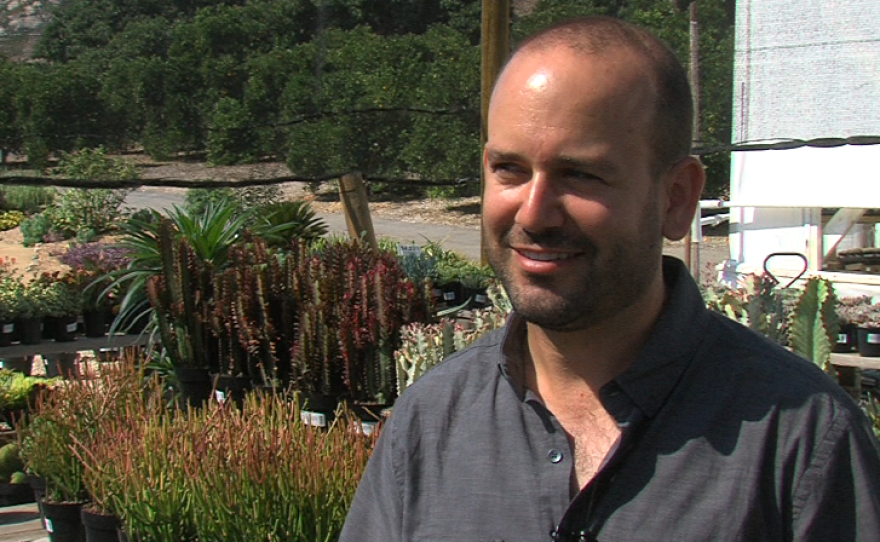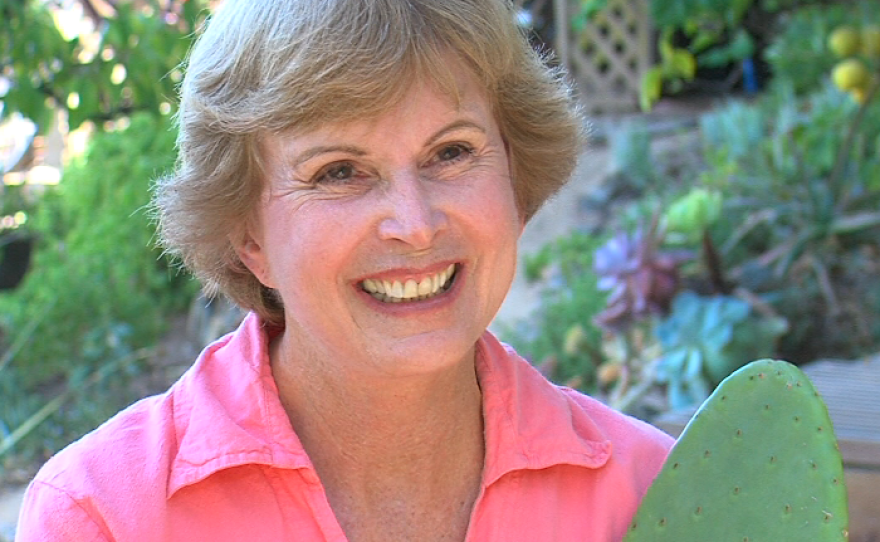As the market for water thirsty plants dries up, sales of cacti and succulents are thriving — and San Diego’s North County is ground zero for all things succulent.
Debra Lee Baldwin’s garden in the hills north of Escondido is full of succulents — plants she learned to love as a child, growing up on an avocado ranch with a father who loved succulents' tough versatility.
“What you don’t realize is that you are in the epicenter of all things succulent," she said as she sat in the shade of an old live oak. "For decades, for generations, we’ve have succulent specialty nurseries here in San Diego and we’ve had collectors, but they were kind of the geeks of the plant world.”
Baldwin is one of the people credited with popularizing succulents and cacti nationwide. Her first book, “Designing with Succulents,” was published in 2007.
“The general public was getting more sophisticated in appreciating foliage over flowers, just as I was in my own garden,” Baldwin said.
Since then, interest in succulents has exploded, and the drought is just reinforcing the gardening trend, Baldwin said.
“When I was researching ‘Designing with Succulents’ in 2006, when I googled the word succulents, I got maybe several hundred thousand hits. If you do that now, you will get in the tens of millions,” she said.
Sales booming
California nurseries are taking advantage of the trend.
David Ross is a buyer for Walter Andersen Nursery in Poway. While sales of many traditional water thirsty garden plants have fallen, succulent and cacti sales increased 25 percent in 2013 and then another 20 percent last year.
“It is definitely helping our business,” Ross said.
“They keep creeping forward and taking tables from ground cover and bedding plants," Ross said. “The vegetable sales have held fairly steady, but the flowers have dropped a bit. And then we’ve added tables down the whole fence line to add in some low water use plants.”
Different varieties of succulents are coming in all the time, Ross added, and that is keeping interest in the plants strong.
Cacti and succulents make up just one percent of San Diego’s $5 billion agricultural economy, according to the latest crop report from San Diego County.
But Eric Larson, executive director of of the San Diego Farm Bureau, said that could be an underestimation since some nurseries that grow succulents don’t distinguish them from other drought-tolerant plants.
Larson said San Diego’s Flower and Plant Association lists about 45 commercial growers that grow cacti and succulents.
Largest cacti, succulent grower in nation
In fact, tucked away up a small country lane in Vista is the largest grower of cacti and succulents in the United States, and possibly the world.
Matt Altman is COO of Altman Plants, which has seen double-digit growth every year since it began.

“Ken and Deena, my parents, they started this business about 40 years ago in their backyard,” Altman said. “They were avid plant collectors, they were really into cacti and succulents - it was a different kind of plant mix. Over time they got too many of them and they just started selling some of them, and that’s how the business started - selling them out of their backyard.”
Since then, the company has grown to more than 2,000 acres. And 1,300 of those acres, mostly in Southern California, are devoted to succulents, according to a company spokesman.
At Altman's Oasis Gardens Nursery north of Escondido, succulent cuttings of all kinds are monitored carefully and watered by hand till they get established.
Altman shows us greenhouses full of rows of pots, planted with red, green and multi-colored succulents.
“This one is called 'Portulacaria,' it’s from Africa,” he said, holding up a plant that resembles a miniature tree with a red trunk and little round green leaves. “Its common name is ‘elephant bush’ because the elephants love to eat it, but it’s pretty indestructible and it’s an amazingly drought tolerant plant.”
Altman Plants started supplying big box stores about nine years ago and that’s when succulent and cacti sales really took off, he said.
New varieties
The company employs two full-time succulent and cacti breeders who travel the world, bringing back new varieties and breeding new hybrids with names like “Crimson Tide,” “Neon Breakers,” and “Mardi Gras,” some of which take years to develop.
Succulents come in every color except cobalt and royal blue, Debra Lee Baldwin said. And there are more and more new ones introduced.
“Plants that collectors were over the moon about and squealed with delight are now common place new breeds of succulent,” she said. “And just like a new invention - maybe in electronics - the price comes down. That’s true, too, of anything that’s seen as rare and collectible, now we’re seeing it become more commonplace and more affordable.“
Some of the most respected specialty succulent growers in the country are also based in North County, Baldwin said, like Rare Succulents, in Rainbow.
Baldwin thinks the cutting edge of this trend will be new kinds of cacti, which, though often sharp or spiky, are even more drought tolerant. She is excited about a new variety of cactus apple which isn’t fancy but has no spines.

”I think people are ready to move past their disdain for cactus,” she said, holding a large, paddle-shaped cactus up to her cheek and stroking it.
“The only thing that I have been able to find online that comes close to it is Opuntia Cacanapa Ellisiana, which I call caress-able cactus,” she said.
Baldwin said the cactus, once rooted, not only need no water, it is also fire resistant. She’s planting it along the edge of her garden as a background plant.
Challenges ahead
Perhaps even more challenging than the water restrictions, finding affordable land to meet the growing demand for these kinds of plants is not so easy any more in North County.
“We’re not finding huge tracts of land to grow cacti and succulents on,“ Altman said. “It’s definitely a challenge, but there’s opportunities here and there.”
Altman Plants has expanded its growing operations to Arizona, Colorado and Texas, though most of the succulent nurseries remain in Southern California. But unlike some nurseries, the company has no plans to outsource their operations overseas.
“A lot of our cactus and succulents in particular, a lot of the collection of varieties is unique to us, you can't find it anywhere else," he said, "And so to be able to manage the requirements of each of those varieties is difficult and requires some expert care."
Altman stops and surveys the surrounding hillsides and scattered greenhouses.
“So I guess, hopefully for many years to come, we can continue to farm here in North County,” he said.








